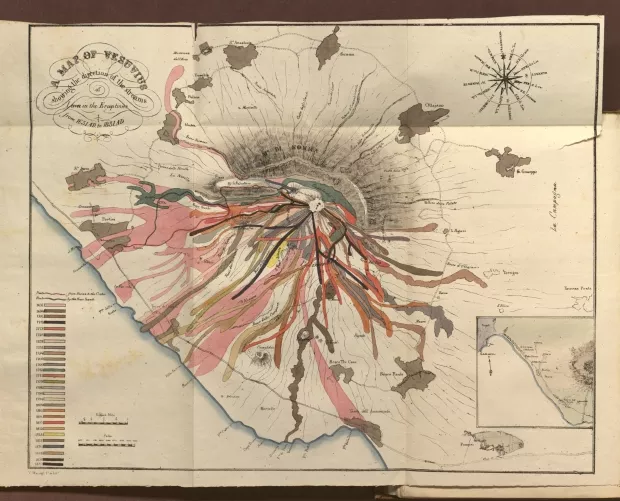Creation Date
1833
Height
29 cm
Width
34 cm
Medium
Genre
Description
This portrayal of Mount Vesuvius’ previous lava flow hints that Romantic culture was cultivating a new interest in volcanism, bolstered by scientific advancements. The image’s significance is neither sublime nor picturesque, yet John Auldjo still drew, copied, and sold this map successfully. This suggests that Romantic culture no longer required the sublime in portrayals of volcanoes, and that the public was becoming more invested in a scientific understanding of volcanoes.
John Auldjo climbed Mount Vesuvius in 1831 as the volcano’s small cone, Monte Somma, was showing activity. Auldjo’s objective was to sketch the volcano to record its activity. He also studied mineral samples in order to discover where the lava had flowed during past eruptions. Upon completion of his voyage to Vesuvius, Auldjo believed citizens should experience his scientific endeavors through the medium of his sketches. Consequently, he published many copies of Sketches of Vesuvius, which narrates his expedition and findings (S. Flowers, "Auldjo, John").
Auldjo was admitted to (and soon dropped out of) the University of Cambridge, where he gained some formal knowledge of botany before climbing Mont Blanc and Mount Vesuvius. John Auldjo’s topographic map of Vesuvius depicting the volcanoe's previous lava flows is meant for scientific purposes alone. During his climb, Auldjo collected mineral samples and dated them to create an accurate survey of the land. Consequently, the function of this map was to show Vesuvius’ eruption history as indicated by lava flow. The scientific community learned much about lava flow in general from this map, as well as the specific tendencies of lava flow on Mount Vesuvius. Such information could be used to better predict what towns might be in danger during an eruption.
This map of Vesuvius is color-coded to indicate the various routes of lava flows traced during Vesuvius’ major eruptions from 1631. Palo, the larger cone, is marked with every lava flow (colored red, brown, and green). Monte Somma is depicted slightly to the left of Palo, and has only one (perhaps two) lava flows. Additionally, walking trails and cities (including Pompeii in the bottom right), along with various landmarks, are depicted in the piece. In the bottom left is a key indicating (by color) when each lava flow occurred. The compass rose is located in the top left.
Auldjo's portrayal of Mount Vesuvius’ previous lava flow hints that Romantic culture was cultivating a new interest in volcanism, bolstered by scientific advancements. The image’s significance is neither sublime nor picturesque, yet John Auldjo still drew, copied, and sold this map successfully. This suggests that Romantic culture no longer required the sublime in portrayals of volcanoes, and that the public was becoming more invested in a scientific understanding of volcanoes.
"A Map of Vesuvius" from Sketches of Vesuvius was created in 1831 shortly after a minor eruption by Vesuvius’ small cone, Monte Somma. This copy of the image was then privately owned by Chester H. Thordarson before arriving in Special Collections at the University of Wisconsin—Madison.
Associated Works
Locations Description
Mount Vesuvius
Classified as a Stratovolcano (one with a tall, multi-layered cone), Mount Vesuvius rises to 4,203 feet (1,281 meters). Within the recent centuries, Vesuvius’ height has decreased due to massive eruptions which have destroyed the volcano’s walls. The volcano is located in the Province of Naples near Pompeii, the city destroyed by its eruption in 79 AD. Today Mount Vesuvius has two craters which emit magma. The larger cone is known locally as Palo. The second, newer cone—formed by massive amounts of magma hardening under pressure—is known as Monte Somma. After the 79 A.D. eruption Mount Vesuvius has erupted about twice every century, with no eruptions occurring after 1944 (S. Bisel Secrets of Vesuvius 2-64).
Mont Blanc
Meaning “white mountain” in French, this snow-topped mountain rises to 15,781 feet (4,810 meters) in northeastern Italy and southeastern France, forming the border between the two countries. The eleventh tallest mountain in the world, Mont Blanc was climbed first by the Italians Jacque Balmat and Michel Paccard in 1786; since then, many have climbed the summit, including John Auldjo in 1827 and Theodore Roosevelt in 1886 (R. Irving, Ten Great Mountains 115-117).
Copyright
Department of Special Collections, Memorial Library, University of Wisconsin-Madison, Madison, WI
Collection
Accession Number
Thordarson T174
Additional Information
Benezit, Emmanuel. Dictionary of Artists. Vol. 9. Paris: Grund, 2006.
Bisel, Sara Louise Clark. Secrets of Vesuvius. New York, NY: Scholastic Inc., 1990.
Flower, S. J. “Auldjo, John (1805–1886).” Oxford Dictionary of National Biography. Ed. H. C. G. Matthew and Brian Harrison. Oxford: OUP, 2004. 2 Apr. 2009 http://www.oxforddnb.com/view/article/37135.
Irving, Robert Lock Graham. Ten Great Mountains. London: J. M. Dent & Sons Limited, 1940.
Mayer, Ralph. HarperCollins Dictionary of Art Terms and Techniques. New York, N.Y: HarperPerennial, 1991.
Ridley, Jasper. The Freemasons A History of the World's Most Powerful Secret Society. Grand Rapids: Arcade Publishers, 2002.
Sichel, Walter Sydney. Memoirs of Emma. New York: P. F. Collier & Son, 1910.
Transactions of the Geological Society of London. Geological Society: London, 1856.

